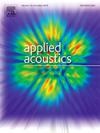Computationally-efficient blind source extraction under extremely low SNR conditions based on principal component analysis
IF 3.4
2区 物理与天体物理
Q1 ACOUSTICS
引用次数: 0
Abstract
Signal extraction under extremely low signal-to-noise ratio (SNR) conditions remains a challenging task in signal processing. Conventional separation and extraction algorithms can achieve satisfactory performance but the computational burden is heavy since they usually involve complicated update rules and require a sufficient number of iterations. In this paper, we prove that, under extremely low SNR conditions, principal component analysis (PCA) can be used as an engineering approximation of the optimal solution for independent vector extraction (IVE). Based on this conclusion, two computationally-efficient methods are proposed to obtain the demixing vector. Both methods involve only a few simple operations and thus require much less computational resources. Numerical experiments across various scenarios demonstrate that the proposed algorithms can achieve comparable performance to conventional algorithms with light computational burden.
求助全文
约1分钟内获得全文
求助全文
来源期刊

Applied Acoustics
物理-声学
CiteScore
7.40
自引率
11.80%
发文量
618
审稿时长
7.5 months
期刊介绍:
Since its launch in 1968, Applied Acoustics has been publishing high quality research papers providing state-of-the-art coverage of research findings for engineers and scientists involved in applications of acoustics in the widest sense.
Applied Acoustics looks not only at recent developments in the understanding of acoustics but also at ways of exploiting that understanding. The Journal aims to encourage the exchange of practical experience through publication and in so doing creates a fund of technological information that can be used for solving related problems. The presentation of information in graphical or tabular form is especially encouraged. If a report of a mathematical development is a necessary part of a paper it is important to ensure that it is there only as an integral part of a practical solution to a problem and is supported by data. Applied Acoustics encourages the exchange of practical experience in the following ways: • Complete Papers • Short Technical Notes • Review Articles; and thereby provides a wealth of technological information that can be used to solve related problems.
Manuscripts that address all fields of applications of acoustics ranging from medicine and NDT to the environment and buildings are welcome.
 求助内容:
求助内容: 应助结果提醒方式:
应助结果提醒方式:


